In praise of the Ford TW-15, the baby giant!
Posted by Chris Graham on 29th March 2024
Chris Graham talks to Tim Pearman about why he rates the Ford TW-15 above the other, more powerful models in this popular range.

Tim Pearman’s 1988 Ford TW-15 4WD is a completely original tractor that’s run for just 5,167 hours. It’s had one previous owner and was scrupulously maintained during its working life.
If you’re in the market for a capable, no-nonsense, Ford tractor with bulletproof mechanicals, power aplenty, classic status and growing residual values, then something from the 1980s TW Series should fit the bill.
Launched in 1979 as high-power successors to the Ford 8700 and 9700, the original TW Series models were built initially for the world market in both Ford’s Romeo, Michigan plant and in Antwerp, Belgium. However, in 1981 production was concentrated at the Belgian factory.
The three-model range available to UK buyers consisted of the 128hp TW-10, the 153hp TW-20 and the flagship, 188hp TW-30. All were powered by versions of Ford’s tried and trusted, six-cylinder, 6.6-litre diesel engine, carried forward from the 8700/9700 models. The entry-level TW-10 was normally-aspirated but the two larger models got turbochargers and the TW-30 also benefitted from an intercooler plus a larger fuel tank (it was physically longer, too).
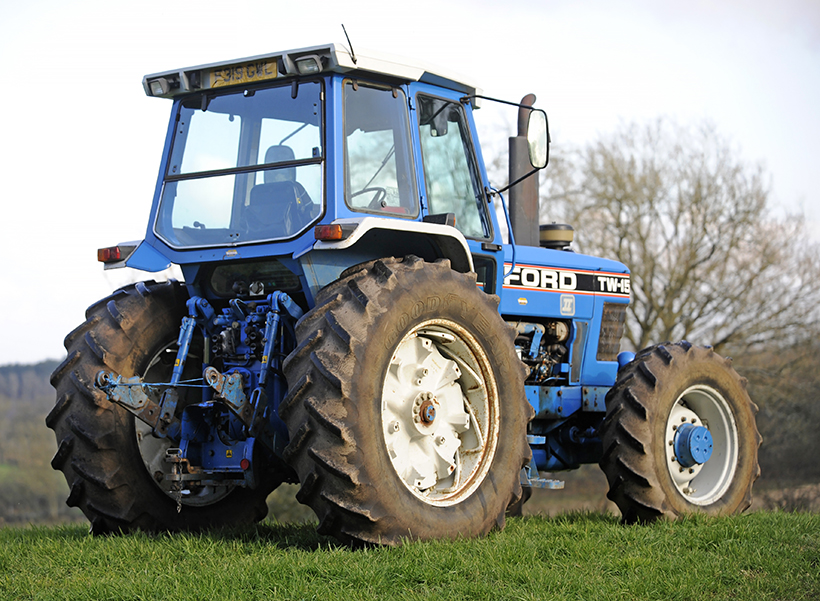
Ford’s Super Q cab was a big selling point for the Force II models, offering drivers luxury features and refinement. It’s still good today, although corrosion beneath the rubbers along the bottoms of the windows is a common problem.
More power!
The TW Series range was upgraded in 1983 with the model names changing and engine outputs increasing to meet demand from power-hungry customers. The entry level model for the European market became the TW-15 which, having gained a turbocharger, produced a healthy 143hp. Further engine tweaks liberated 156hp for the mid-range TW-25 while the output of the range-topping TW-35 was boosted to an impressive 190hp.
Although the option of two-wheel-drive had been available across the range from the start (‘TW’ denotes ‘two-wheel-drive’, with most on the American market being specified this way), the vast majority of European models were sold with factory-fitted four-wheel-drive, delivered by a ZF front axle. This was changed from an offline to a centreline driveshaft design as part of the 1983 model upgrade and, at the same time, rudimentary electronics started to enter the picture. This included the arrival of an optional Performance Monitor.
The final big step in the TW Series development story occurred in 1985, with the arrival of Force II. This enhancement was applied across the TW and 10 Series ranges and, apart from a range of mechanical improvements and the addition of ‘II’ Roman numeral bonnet decals, the most eye-catching change was the introduction of the Super Q cab. This provided a big improvement in terms of driver comfort offering, as it did, enhanced sound deadening, a flat floor, optional air conditioning, an opening roof hatch and integrated front (four) and rear (two) work light built into the redesigned roof that also housed the cab’s air filters.
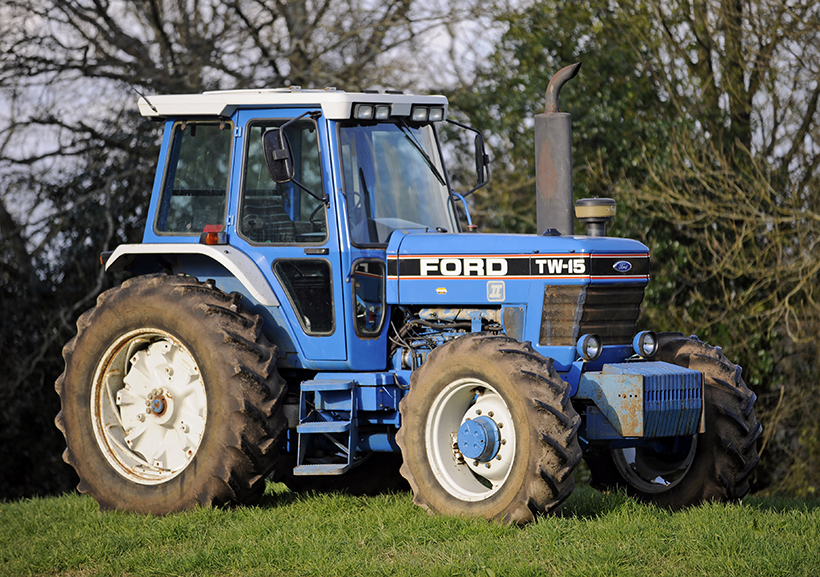
The TW-15 is still running on its original tyres but, due to the evident cracking, Tim is fully expecting them to start leaking anytime soon.
A digital dashboard became another option and, on the mechanical side of things, the back end was strengthened and more powerful hydraulics were specified, in an attempt to cope with the ever larger and heavier implements that were becoming available at the time. The TW Series range continued in production until 1989, when it was replaced by the 30 Series, by which time the writing was already on the wall for Ford-branded tractors, but that’s another story.
Model choice
One man who is well placed to comment on the virtues of the TW Series tractors is Worcestershire-based enthusiast, Tim Pearman, whose collection of Super Q-cabbed Ford tractors includes a 4WD TW-35, a 2WD TW-25 and the very original, low-hours 4WD TW-15 you see here. We’ve decided to feature this model for a couple of reasons. First is the fact that it’s usually the flagship TW-35 that grabs the lion’s share of coverage in articles like this, so I thought it would be good to turn the tables, and focus on an entry-level model for a change. But, secondly, it also transpires that the TW-15 is actually Tim’s favourite from the range, but more of that later.
To begin with I wanted to learn more about this TW-15’s backstory, including when and where Tim found it. “I actually came across this tractor completely by chance,” he explained. “I’d gone to a farm in Northampton to look at a TW-30 that I was interested in buying. While I was there I noticed the farmer’s still-working TW-15, which was evidently his pride and joy. It looked to be in excellent condition, despite still being in regular use. Unfortunately, though, he simply wasn’t ready to sell it.
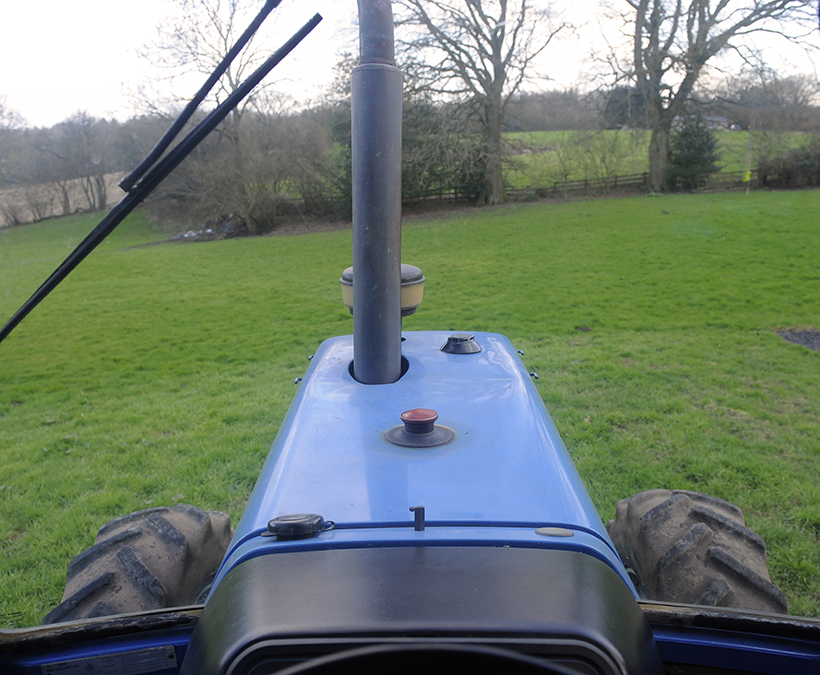
The TW-15’s compact size makes it easy to drive and manoeuvrable; ideal for general work… and tractor road runs!
“I could tell instantly that the TW-15 was a decent machine but, at that stage, I had to content myself with the TW-30 which, once we agreed a price, I bought. As it turned out, that wasn’t a great example and I moved it on pretty quickly after that, but the TW-15 stuck in my mind.”
Previous experience
Tim had had some previous – and largely positive – experience with a ‘small’ TW machine. “We’d owned a TW-10 4WD back in the day,” he told me, “which we worked for a number of years. It was a very good tractor that gripped impressively well, but it’s only weakness was that, with an output of around 110hp, it was a little underpowered, given its size and weight. However, when the TW-15 arrived with its 140hp, that extra 30hp made a lot of difference in the real world.
“I really liked the TW-15 because it hit the sweet spot in terms of power and size. While the TW-25 and 35 models certainly produce more power, they’re physically bigger, which tends to make them less practical for many of the typical jobs on a normal farm. Granted, the extra length of the bigger models means they’re well suited to pulling big ploughs, but a TW-15 with a decent set of weights on the front can be very productive. I appreciate that it’s very much a case of horses for courses in terms of model choice, but the degree of practical versatility that the TW-15 offers counts for a lot, as far as I’m concerned.”
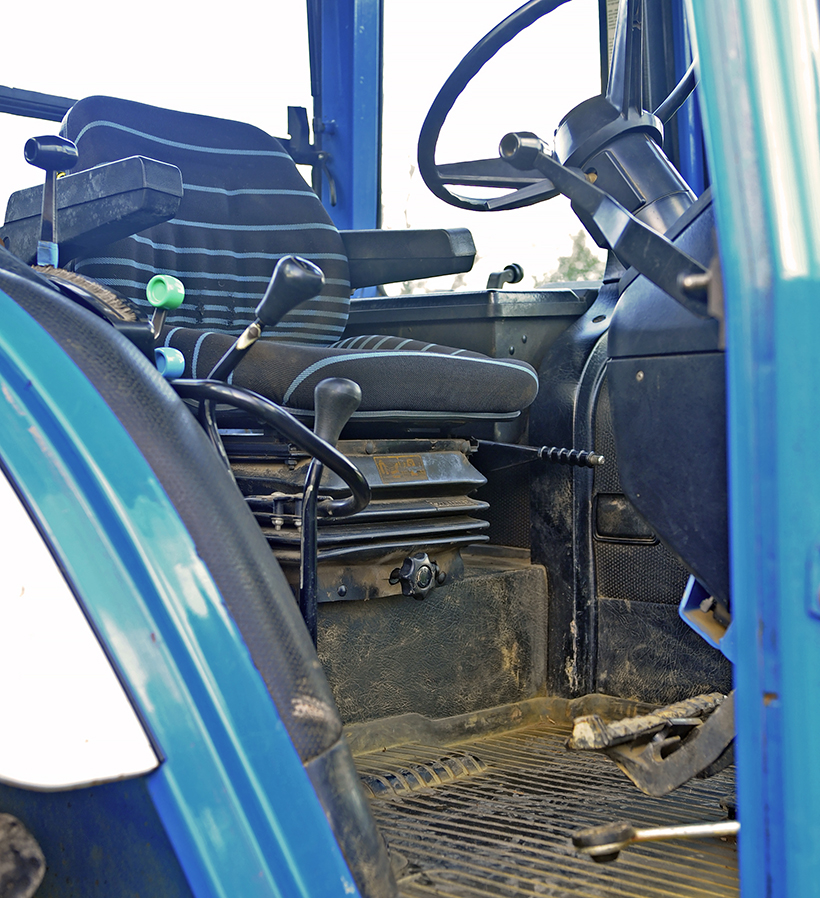
The seat and interior trim are all original, and in fine condition.
As it turned out, Tim only had to wait about six months before the TW-15 owner got back in touch with the news that he was now ready to sell. “I was delighted to finally get the machine and, once it was back here, I found myself even more impressed. This was back in 2005, and the farmer had owned and used the tractor from the day it arrived with him as a new machine in 1988.
“I was amazed by the care and attention the farmer had lavished on this tractor during its working life and even the final service he’d had done – not long before I bought it – was incredibly thorough. For example, even the rear axle and transmission oil had been changed and, in my experience, not many owners bother to do that. The coolant was changed too, as was the front axle oil and the oil in the hubs. It truly had been nurtured and I quickly realised how lucky I was that this one had fallen into my lap.”
No trouble, at all!
Tim continued: “I genuinely found it in tip-top condition and I can’t recall it needing any work at all during the 19 years it’s been with me. As a result, the tractor remains in completely original condition, and I’m very keen to keep it that way. I think that the previous owner worked it reasonably hard from new, although it had been extremely well maintained, too. He ran a mixed farm with livestock and arable, so its 5,100 hours would have been spent doing a complete variety of jobs. When I first saw it, it was fitted with a Dowdeswell plough, and I know he used it with a forage harvester, too.
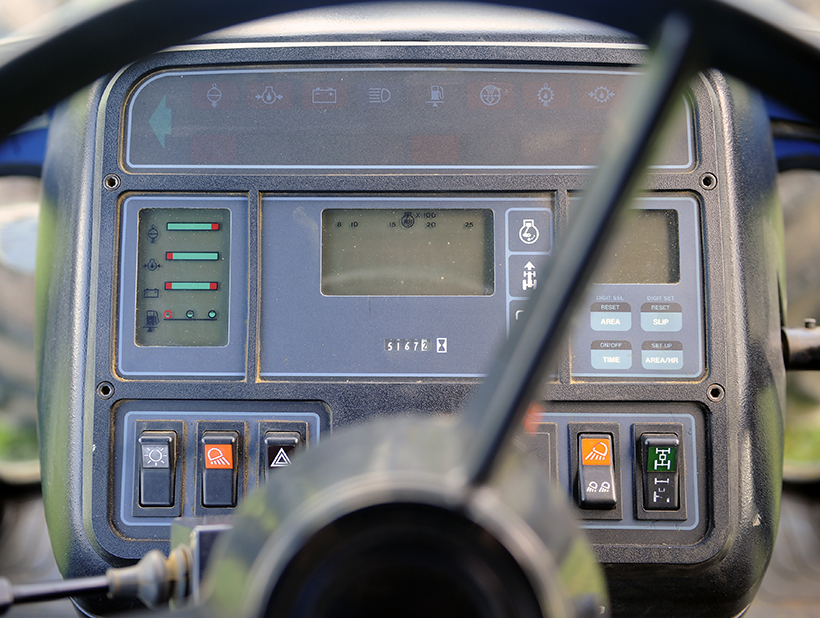
A sign of things to come. The arrival of the digital dash as an option on TW Series models was one of the trail-blazers for electronic control in tractors. Instrumentation like this can cause age-related issues but, so far, this one’s proved reliable.
“One of the reasons I like this tractor so much – and why it’s my favourite from the Super Q-cabbed TW range – is that its lower engine power output means it spends its working life operating comfortably within its mechanical tolerances. The larger TW-25 and 35 models produce a lot more power, but they’re heavier, and yet all three have the same running gear. Pushing 140hp through a gearbox plus front and rear axles that are designed to cope with 190hp, is bound to lead to a longer and more reliable service life, in my view.
“It’s for this reason that, in the case of machines that need to work, I always tend to avoid the most powerful models. Mechanical parts aren’t as durable as they were in the good old days. The tractor-pulling boys who regularly put 600hp through a Fordson Major back end that was designed to cope with 50hp, would get nowhere taking a similar approach on modern machinery! Internal components are built to a price nowadays; inherent ‘over-engineering’ isn’t a feature like it used to be.”
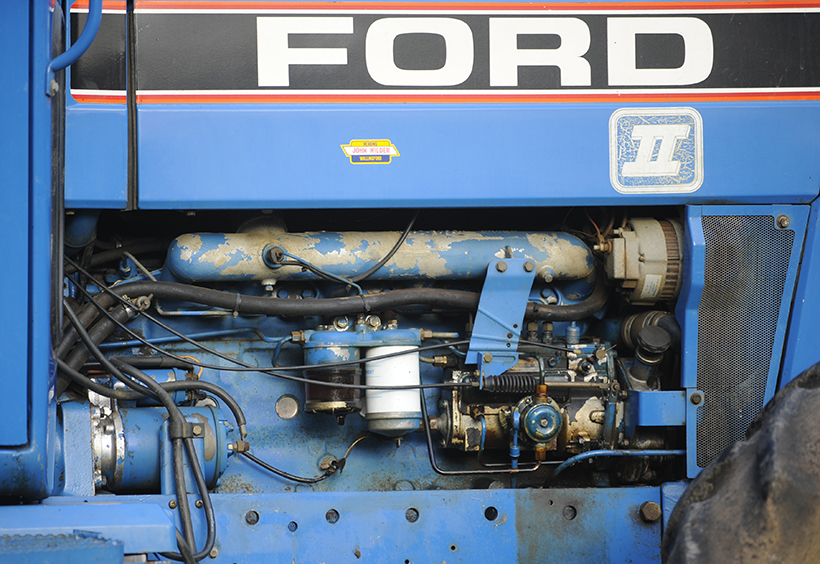
Ford’s 6.6-litre diesel hasn’t missed a beat during Tim’s 19-year ownership even though, as he admitted to me, it’s still running on the same oil that was in it when he bought it!
Mechanical leeway
“As far as I’m concerned, opting for a TW-15 instead of a TW-35 will ensure a comforting degree of ‘mechanical leeway’, meaning that all the operating systems will be far less stressed. I’m a great believer in keeping things as simple as possible when it comes to tractor design, and the fact that models like the TW-15 aren’t awash with complicated electronic control systems, is a real plus point, especially when machines like this fall into enthusiast hands.
“To illustrate the point, this tractor probably hadn’t run for a couple of years before today. Nevertheless, all I had to do was connect a battery, turn the key and away she went, running smoothly and evenly from the off. I simply don’t believe that such a thing would be possible with a newer, computer-controlled New Holland. I had a late 1990s New Holland 8340, and that tractor suffered with so many niggling electrical problems that I just couldn’t trust it, and had to cut my losses and sell it.”
While Tim concedes that today’s tractor electronics are better and more reliable than those early systems introduced in the 1990s, he still has his doubts about their long-term reliability in the harsh, farming environment. “I’m not sure that many of today’s high-tech tractors will still be fully functional in 36 years’ time, in the same way that my TW-15 is now. There’s just too much to go wrong on them and the cost of replacement electronic control units means that the expense associated with electrical repairs could well prove to be at the root of many premature insurance write-offs.

Tim’s tractor has never had anything heavy attached to it during its time with him, and has been confined to dump trailer and mowing duties.
“I think more operators in the industry are coming to realise this, which is why an increasing number of farmers are turning to tractors from just before electronics really took a hold. Those machines can still deliver perfectly acceptable performance but, crucially, they couple that with good reliability, straightforward maintenance requirements and a value-for-money price tag.”
Final thoughts
Clearly, Tim Pearman is a big fan of the later TW Series tractors, and his opinions are based on many years of practical experience with assorted examples. He considers that these late models, that came just before the Ford operation morphed into New Holland, represent the pinnacle of tractor design, in terms of inherent reliability, functionality, and affordability.
The arrival of electronics into the world of agricultural tractors certainly brought with it enhanced levels of controllability, efficiency and ease of operation, but there were downsides, too. Purchase prices ballooned, reliability appeared to decline and the prospect for DIY maintenance and repair was gradually wrestled from the farmer, increasing the overall cost of ownership.
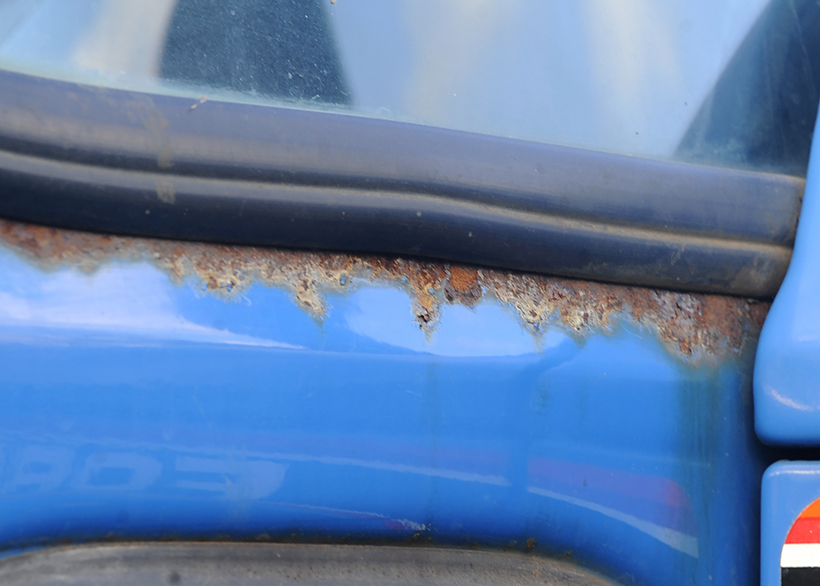
This is the sort of rust that commonly afflicts Ford’s Super Q cab.
“I think that more or less everything about the TW Series tractor is good; they even look right,” Tim added. “This TW-15 has only been used for light duties since I’ve had it, towing the occasional dump trailer or working with a grass cutter. There’s been nothing heavy on the back although, as with all other aspects of this particular one, the hydraulics have proved to be faultless over the past 19 years.”
Tim has no plans on the restoration front for the TW-15. “Mechanically it’s very sound,” he explained, “and, although there’s some surface rusting on the rear wheel rims, the chassis frame and along the bottoms of some of the cab windows, I’m really not that bothered about that. I could have that all put right but, to be honest, the tractor is so fantastically original that I think messing about with fresh paint here and there would spoil it.

Tim currently owns three Super Q-cabbed TWs, but has had many others in the past. He regards these models as just about as good as it gets in terms of practical, usable, reliable and financially appreciating tractors.
“My feeling is that more and more people are now coming to appreciate seeing classic tractors in original condition, and that trend is certainly being reflected in the prices achieved at auctions. Good, original-condition tractors are now selling better than bright and shiny, fully-restored examples. To illustrate that point, I had two Muir-Hills on the FFA’s stand at Tractor World recently. One has been fully done up while the other is still in off-farm condition, and it was the unrestored example that was attracting all the attention from visitors, which says it all, really.”
This feature comes from the latest issue of Ford & Fordson Tractors, and you can get a money-saving subscription to this magazine simply by clicking HERE
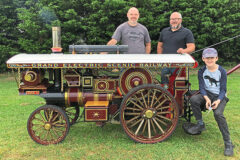
Previous Post
A superb Burrell showman’s engine project
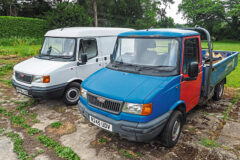
Next Post
Singing the praises of the cheap and cheerful LDV Pilot



